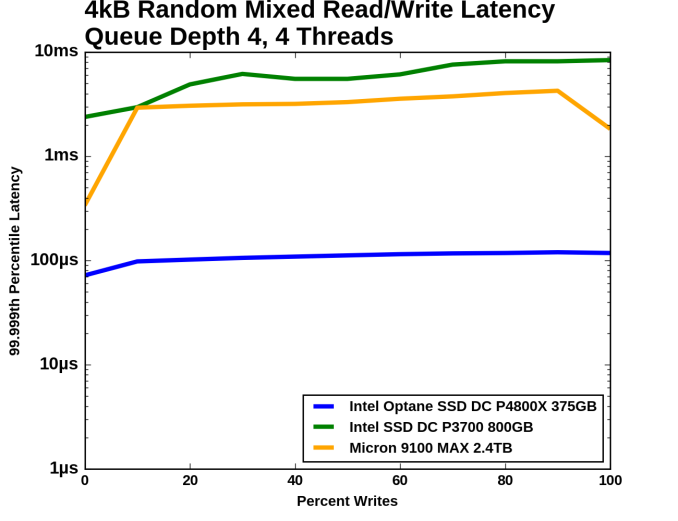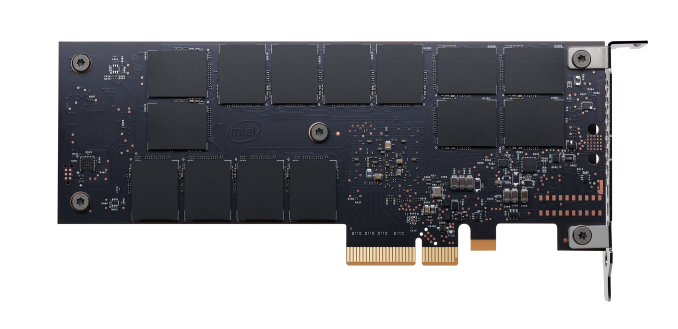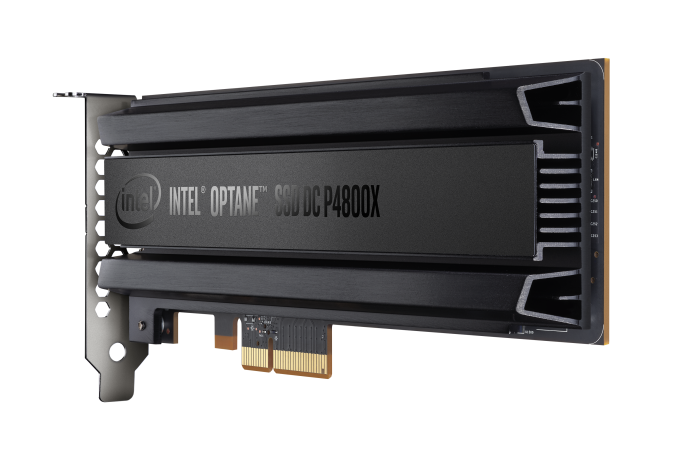The Intel Optane SSD DC P4800X (375GB) Review: Testing 3D XPoint Performance
by Billy Tallis on April 20, 2017 12:00 PM ESTFinal Words: Is 3D XPoint Ready?
The Intel Optane SSD DC P4800X is a very high-performing enterprise SSD, but more importantly it is the first shipping product using Intel's 3D XPoint memory technology. After a year and a half of talking up 3D XPoint, Intel has finally shipped something. The P4800X proves that 3D XPoint memory is real and that it really works. The P4800X is just a first-generation product, but it's more than sufficient to establish 3D XPoint memory as a serious contender in the storage market.
If your workload matches its strengths, the P4800X offers performance that cannot currently be provided by any other storage product. This means high throughput random access, as well as very strict latency requirements - the results Optane achieves for it's quality of service for latency on both reads and writes, especially in heavy environments with a mixed read/write workload, is a significant margin ahead of anything available on the market.

At 50/50 reads/writes, latency QoS for the DC P4800X is 30x better than the competition
The Intel Optane SSD DC P4800X is not the fastest SSD ever on every single test. It's based on a revolutionary technology, but no matter how high expectations were, very rarely does a first-generation product take over the world unless it becomes ubiquitous and cheap on day one. The Optane SSD is ultimately an expensive niche product. If you don't need high throughput random access with the strictest latency requirements, the Optane SSD DC P4800X may not be the best choice. It is very expensive compared to most flash-based SSDs.
With the Optane SSD and 3D XPoint memory now clearly established as useful and usable, the big question is how broad its appeal will be. The originally announcements around Optane promised a lot, and this initial product delivers a few of those metrics, so to some extent, the P4800X may have to grow its own market and reteach partners what Optane is capable of today. Working with developers and partners is going to be key here - they have to perform outreach and entice software developers to write applications that rely on extremely fast storage. That being said, there are plenty of market segments already that can never get enough storage performance, so anything above what is available in the market today will be more than welcome.
There's still much more we would like to know about the Optane SSD and the 3D XPoint memory it contains. Since our testing was remote, we have not yet even had the chance to look under the drives's heatsink, or measure the power efficiency of the Optane SSD and compare it against other SSDs. We are awaiting an opportunity to get a drive in hand, and expect some of the secrets under the hood to be exposed in due course as drives filter through the ecosystem.












117 Comments
View All Comments
ddriver - Sunday, April 23, 2017 - link
It is not expensive because it is new, it is expensive because intel and micron wasted a crapload of money on RDing it and it turned out to be mediocre - significantly weaker than good old and almost forgotten SLC. So now they hype and lie about it and sell it significantly overpriced in hopes they will see some returns of the investment.Also, it seems like you are quite ignorant, ignorant enough to not know what "order of magnitude" means. You just heard someone smart using it and decided to imitate, following some brilliant logic that it will make you look smart. Well, it doesn't. It does exactly the opposite. Now either stop using it, or at the very least, look it up, understand and remember what it actually means, so the next time you use it, you don't end up embarrassing yourself.
factual - Sunday, April 23, 2017 - link
"significantly weaker than good old and almost forgotten SLC"Seriously ?! You must be getting paid to spew this bs! no one can be this ignorant!! can you read numbers ?! what part of 8.9us latency don't you understand, this is at least 10x better than the latest and greatest NVMe SSDs (be it TLC, VNAND or whatever bs marketing terms they feed idiots like you nowadays).
what part of 95K/108K QD1 IOPS don't you understand ?! This is 3-10x compared to this best SSDs on the market.
So I repeat again, Xpoint is orders of magnitude better performing than the latest and greatest SSDs (from Samsung or whichever company) on the market. This is a fact.
You don't even understand basic math, stop embarrassing yourself by posting these idiotic comments!
ddriver - Monday, April 24, 2017 - link
LOL, your intellect is apparently equal to that of a parrot.factual - Monday, April 24, 2017 - link
Well if this fruitless exchange is any evidence my intellect is far superior to yours. So If my intellect is equal to that of a parrot, yours must be equal to that of a maggot ... lolevilpaul666 - Saturday, April 22, 2017 - link
So where are the 32gb client ones?tomatus89 - Saturday, April 22, 2017 - link
Who is this ddriver troll? Hahaha you are hillarious. And the worse is that people keep feeding him instead of ignoring him.peevee - Saturday, May 27, 2017 - link
From your testing, looks like the drive offers real advantages on low QD, i.e. for desktop/small office server use. For these uses a normal SSD is also enough though.Given that modern Xeons have up to 28 cores (running 56 threads each) and server motherboards have 2 or more CPU slots, a properly loaded server will offer QD > 64 all day long, and certainly not just 4 active threads - where the Micron 9100 offers even higher performance, and if the performance is good enough there, it certainly good enough on lower QDs where it is even better PER REQUEST.
And who cares what 99.999% latency is, as long as it is milliseconds and not seconds - network and other latencies on the accesses to these servers will be higher anyway.
An incredibly good first attempt, but it really does not push the envelope in the market it is priced for - high-performance storage-bottlenecked servers.